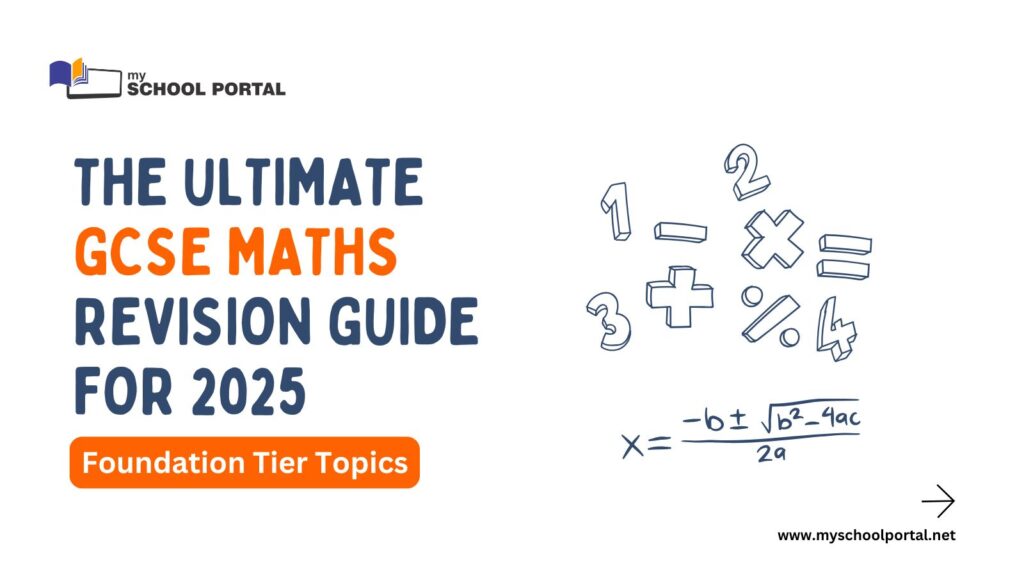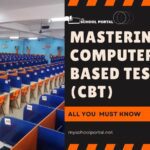If you’re preparing your Year 10 and Year 11 students for their GCSE Maths exams in 2025, this guide is your go-to resource. It highlights the most essential Foundation Tier topics and offers practical tips to help students excel. With links to free resources, revision guides, and strategies, we’ll ensure your students are equipped to tackle their exams with confidence.
Why Focus on These GCSE Maths Topics?
The GCSE Maths curriculum is comprehensive, covering a range of interconnected topics. However, certain topics are assessed more frequently and hold greater weight in the exams. By prioritizing these areas, students can maximize their marks while building a solid mathematical foundation.
Let’s explore the six main topic areas for the Foundation Tier:
- Number
- Algebra
- Ratio, proportion, and rates of change
- Geometry and measure
- Probability
- Statistics
These topics apply universally across exam boards, including Edexcel, AQA, and OCR. Below, we’ll dive deeper into each one, providing actionable insights and tips for effective preparation.Section 1: Number
Key Topics to Focus On
The “Number” topic serves as the foundation of GCSE Maths. Here are the crucial subtopics to prioritize:
- Four Operations: Mastery of addition, subtraction, multiplication, and division is critical. Students should also practice calculations involving fractions, decimals, and negative numbers.
- Order of Operations (BODMAS): Ensure students understand the correct sequence for solving multi-step calculations.
- Fractions, Decimals, and Percentages (FDP): Teach conversions between these forms, emphasizing real-world applications like discounts and interest rates.
- Place Value and Standard Form: Familiarize students with writing large or small numbers efficiently.
- Factors, Multiples, and Primes: Include practice on HCF, LCM, and prime factorization.
- Estimation and Rounding: Help students improve accuracy by estimating answers and rounding values appropriately.
Real-World Applications
Link mathematical concepts to practical scenarios to make learning engaging and relatable. For example:
- Shopping Budgets: Compare discounts and calculate savings.
- Utility Bills: Work out total costs based on consumption.
- Wage Increases: Calculate percentage increases in salaries.
- Recipes and Proportions: Adjust quantities for different servings.
Exam Insights
Analysis of past GCSE Foundation Tier papers reveals that number skills and proportional reasoning are central to success. Many questions assess students’ ability to apply numerical concepts to real-life contexts. For instance, calculating best buys or interpreting meter readings are common scenarios.
Key Preparation Tips
- Practice Context-Based Problems: Encourage students to solve questions involving everyday scenarios like shopping or planning holidays.
- Reinforce FDP Skills: Use step-by-step guides and visual aids to explain conversions.
- Memorize Key Facts: Students should know key formulas and concepts, such as square roots and powers, without relying on formula sheets (which will not be available in 2025).
- Utilize Free Resources: Access free practice papers, worksheets, and revision guides tailored to Edexcel, AQA, and OCR exam boards.
Infrequently Assessed Topics
While most number-related content is essential, some topics, such as standard form problems or rich tasks involving LCM and HCF, appear less often. However, they remain valuable for building mathematical thinking.
Section 2: Algebra
Key Topics to Focus On
Algebra is a core component of GCSE Maths, emphasizing problem-solving and abstract thinking. Here are the critical subtopics students should master:
- Simplifying Expressions: Teach students how to combine like terms, simplify expressions, and use the laws of indices effectively.
- Expanding and Factorizing: Focus on expanding single and double brackets and factorizing linear and quadratic expressions.
- Solving Equations and Inequalities: Cover linear equations, inequalities, and introducing simultaneous equations.
- Graphs: Familiarize students with plotting straight-line graphs, identifying gradients and intercepts, and interpreting real-world graph contexts.
- Sequences: Introduce arithmetic and geometric sequences, including nth-term calculations.
Infrequently Assessed Topics
While the Foundation Tier focuses more on linear algebra, the following topics appear less frequently:
- Quadratic Equations: Solving quadratics of the form x2+bx+c=0x^2 + bx + c = 0x2+bx+c=0.
- Cubic and Reciprocal Graphs: Understanding less common graph types.
- Advanced Vocabulary: Differentiating between equations, identities, and formulae.
Real-World Applications
Make algebra relatable by applying it to real-life problems:
- Formulas in Action: Use algebra to calculate distances, costs, or other practical quantities.
- Graphs in Context: Interpret graphs in scenarios such as speed-time relationships or budget planning.
- Inequalities in Decision-Making: Show how inequalities help in scenarios like allocating budgets or setting limits.
Exam Insights
Past Foundation Tier exam analysis reveals that algebra questions often combine several subtopics. For example, solving a linear equation may also involve simplifying an expression or working with indices. Graph-related questions are typically straightforward but require precision in plotting and interpreting.
Key Preparation Tips
- Master the Algebra Toolkit: Ensure students are confident with basics like simplifying, expanding, and solving equations before tackling complex problems.
- Focus on Straight-Line Graphs: Practice plotting and interpreting y=mx+cy = mx + cy=mx+c, as these are common in exams.
- Provide Step-by-Step Guidance: Use scaffolded worksheets to help students break down multi-step algebra problems.
- Practice Using Past Papers: Work through exam-style questions to familiarize students with the types of algebra problems they’ll encounter.
Resources to Use
Encourage students to access free resources, such as downloadable worksheets and revision guides. These resources often include:
- Example problems with detailed solutions.
- Practice questions ranging from basic to advanced.
- Graphing activities with real-life scenarios.
Final Note on Algebra
While algebra can seem abstract, building confidence in this area is critical for success across other topics. Many geometry and ratio problems, for example, require algebraic manipulation, making this a high-value focus area for revision.
Section 3: Ratio, Proportion, and Rates of Change
Key Topics to Focus On
Ratio, proportion, and rates of change are essential for real-world problem-solving. These subtopics should be prioritized during revision:
- Ratio:
- Simplifying ratios.
- Sharing amounts in a given ratio.
- Working with three-part ratios.
- Proportion:
- Direct and inverse proportion problems.
- Solving problems involving recipes, scaling, or currency conversions.
- Rates of Change:
- Speed, distance, and time calculations.
- Unit conversions (e.g., km/h to m/s).
- Gradient as a measure of rate of change in graphs.
Infrequently Assessed Topics
Some topics under this strand appear less frequently on the Foundation Tier:
- Complex proportional reasoning, such as compound measures like density or pressure.
- Advanced multi-step problems, where proportional reasoning is integrated with other topics (e.g., geometry or algebra).
Real-World Applications
Students often encounter ratio and proportion in daily life, making it a highly practical area of study. Example scenarios include:
- Budget Planning: Dividing finances in a set ratio (e.g., savings, spending, donations).
- Recipe Adjustments: Scaling ingredients up or down for different portion sizes.
- Travel Planning: Calculating time required for a journey given speed and distance.
Exam Insights
Exam boards frequently assess ratio and proportion through real-life contexts. Common themes include:
- Converting units (e.g., grams to kilograms or liters to milliliters).
- Interpreting proportional graphs or tables.
- Multi-step problem-solving involving percentages or compound measures.
Key Preparation Tips
- Master Proportional Reasoning: Ensure students are comfortable identifying whether problems involve direct or inverse proportion.
- Practice Word Problems: Provide ample examples of real-world scenarios requiring ratio and proportion.
- Work with Graphs: Help students understand how proportional relationships are represented graphically.
- Focus on Speed and Accuracy: Build fluency in calculations involving rates of change, as these are time-intensive in exams.
Common Misconceptions to Address
- Confusing direct and inverse proportion.
- Misinterpreting the “total” in ratio problems (e.g., dividing amounts incorrectly).
- Forgetting to use consistent units in rates of change calculations.
Resources to Use
Encourage students to use step-by-step revision materials that focus on proportional reasoning. These resources typically include:
- Scaffolded worksheets for ratios and proportions.
- Practice problems with real-world contexts (e.g., cooking, construction, travel).
- Graphing activities to visualize proportional relationships.
Final Note on Ratio and Proportion
Success in this topic often depends on clear problem-solving strategies. Students should practice breaking problems into smaller steps, ensuring they understand the underlying relationship before attempting calculations.
Section 4: Geometry and Measure
Key Topics to Focus On
Geometry and measure form a significant portion of the GCSE Foundation Tier syllabus. It emphasizes spatial reasoning and the application of measurement concepts. The key subtopics include:
- Properties and Constructions:
- Angles: Angle facts (on a straight line, at a point, in polygons).
- Types of triangles and quadrilaterals, including their properties.
- Constructing angles, triangles, and bisectors using a compass and ruler.
- Mensuration and Calculation:
- Perimeter, area, and volume calculations for 2D and 3D shapes.
- Surface area of prisms, cylinders, and simple composite shapes.
- Working with circles (circumference, area).
- Pythagoras’ Theorem (basic applications).
- Vectors:
- Understanding vector notation and basic vector arithmetic (addition and subtraction).
- Graphical representation of vectors.
Infrequently Assessed Topics
Some geometry topics appear less often in Foundation Tier exams:
- Advanced constructions, such as loci or constructions involving arcs.
- Complex transformations, like combinations of transformations or enlargement with fractional scale factors.
- Advanced vector problems, including geometric proofs involving vectors.
Real-World Applications
Geometry and measure have practical applications in everyday contexts. Examples include:
- Home Improvement: Calculating areas of walls or floors for painting or tiling.
- Packaging Design: Estimating the surface area and volume of boxes or containers.
- Navigation: Using angle facts and coordinates to determine positions or routes.
Exam Insights
Exam boards assess geometry and measure through a variety of question types:
- Procedural calculations for area, perimeter, or volume.
- Context-based questions involving dimensions of real-world objects (e.g., rooms, parcels).
- Problem-solving questions involving combinations of geometrical properties (e.g., using Pythagoras’ Theorem to find missing dimensions).
Key Preparation Tips
- Master Key Formulas: Students should memorize essential formulas for area, volume, and circle calculations, as these are no longer provided in exams.
- Focus on Visualization: Practice drawing diagrams to support problem-solving.
- Use Step-by-Step Approaches: Break down multi-step geometry problems into smaller, manageable tasks.
- Practice Transformations: Include plenty of practice on reflecting, rotating, translating, and enlarging shapes.
Common Misconceptions to Address
- Confusion between radius and diameter when calculating circles.
- Misapplying units (e.g., forgetting to square units for area or cube them for volume).
- Errors in angle calculations (e.g., forgetting that the angles in a triangle sum to 180°).
- Overlooking the need to convert units (e.g., cm to m) before calculations.
Resources to Use
Provide students with resources that focus on geometry fundamentals, including:
- Worksheets for practicing perimeter, area, and volume calculations.
- Interactive activities for transformations and constructions.
- Problem sets involving real-world contexts (e.g., designing a garden or packaging).
Final Note on Geometry and Measure
This topic requires both procedural fluency and conceptual understanding. Students should be encouraged to practice a wide variety of problems and to approach geometry questions systematically. For best results, integrate geometry topics with algebra and number concepts to build a well-rounded skill set.
Section 5: Probability
Key Topics to Focus On
Probability is a crucial yet straightforward topic in the GCSE Foundation Tier. It often requires students to combine basic numerical skills with logical reasoning. Key areas to emphasize include:
- Basic Probability Principles:
- Probability scale from 0 to 1 (including terminology: impossible, unlikely, even chance, likely, certain).
- Calculating probabilities of single events (e.g., flipping a coin, rolling a dice).
- Understanding and calculating complementary probabilities (e.g., P(A′)=1−P(A)P(A’) = 1 – P(A)P(A′)=1−P(A)).
- Listing Outcomes and Sample Spaces:
- Systematically listing outcomes for experiments (e.g., tossing two coins, rolling two dice).
- Using sample space diagrams to calculate probabilities.
- Mutually Exclusive and Independent Events:
- Understanding mutually exclusive events (e.g., outcomes that cannot occur together).
- Understanding and calculating probabilities of independent events using P(A and B)=P(A)×P(B)P(A \text{ and } B) = P(A) \times P(B)P(A and B)=P(A)×P(B).
- Frequency and Relative Frequency:
- Calculating relative frequency as an estimate of probability from experiments.
- Comparing theoretical probability with experimental results.
Infrequently Assessed Topics
The following topics are less common but may still appear occasionally:
- Tree diagrams for independent events at Foundation Tier.
- Venn diagrams with probabilities.
- Conditional probability problems (more common in Higher Tier).
Real-World Applications
Probability is a highly applicable topic with real-life relevance, making it easier for students to understand its practical use. Examples include:
- Weather Forecasting: Interpreting the likelihood of rain or sunshine based on probabilities.
- Sports: Evaluating the probability of a team winning a match or a player scoring.
- Games and Lotteries: Analyzing chances of winning in games of chance.
Exam Insights
Probability questions in Foundation Tier exams typically test:
- Simple Probability Calculations: For example, finding the probability of picking a red ball from a bag with a mix of colored balls.
- Combined Events: Determining probabilities for two or more events occurring, often using diagrams or logical reasoning.
- Experimental Probability: Questions may require students to analyze frequency tables or charts and use relative frequency to estimate probabilities.
Key Preparation Tips
- Master Probability Basics: Students should practice calculating probabilities using fractions, decimals, and percentages interchangeably.
- Practice Interpreting Visuals: Teach students how to read and use sample spaces, tree diagrams, and frequency tables.
- Focus on Real-Life Contexts: Use practical examples to build understanding and interest.
- Reinforce Complementary Events: Emphasize the importance of P(A′)=1−P(A)P(A’) = 1 – P(A)P(A′)=1−P(A) in multi-step problems.
Common Misconceptions to Address
- Misunderstanding that probabilities cannot exceed 1 or be negative.
- Confusing independent events with mutually exclusive events.
- Incorrectly interpreting frequency tables or sample space diagrams.
- Assuming outcomes are equally likely when they are not (e.g., biased dice or weighted coins).
Resources to Use
To support learning, use resources like:
- Worksheets with progressively challenging probability problems.
- Interactive activities using dice, coins, or spinners to simulate experiments.
- Visual aids, including sample space diagrams and frequency charts.
Final Note on Probability
Probability questions often involve logical reasoning and a structured approach to calculations. Encourage students to take their time, write out steps clearly, and double-check their answers to avoid careless errors. Pair probability with statistics for a comprehensive approach to data analysis and interpretation.
Section 6: Statistics
Key Topics to Focus On
Statistics involves analyzing, summarizing, and presenting data. For the GCSE Foundation Tier, this topic is crucial because it overlaps with real-life scenarios, making it easier for students to relate to. Key areas include:
- Data Collection and Types of Data:
- Recognizing and categorizing data as discrete or continuous.
- Understanding primary and secondary data.
- Designing and interpreting surveys or questionnaires.
- Representing Data:
- Drawing and interpreting bar charts, pie charts, line graphs, and pictograms.
- Plotting scatter graphs and understanding correlation (positive, negative, or no correlation).
- Box plots (more common at Higher Tier but occasionally appear in Foundation Tier).
- Measures of Central Tendency and Spread:
- Calculating the mean, median, mode, and range.
- Identifying and interpreting the significance of each measure.
- Understanding when each measure is appropriate to use.
- Frequency Tables and Grouped Data:
- Interpreting and constructing frequency tables.
- Estimating the mean from grouped data using midpoints.
- Identifying modal class and estimating median from cumulative frequency diagrams.
- Probability in Statistics:
- Calculating probabilities from data presented in charts, tables, or graphs.
Infrequently Assessed Topics
While these topics appear less frequently, they still merit some practice:
- Stem-and-leaf diagrams.
- Histograms (with unequal intervals).
- Sampling techniques (systematic, random, and stratified sampling).
Real-World Applications
Statistics is one of the most practical areas of mathematics, with wide-ranging real-world applications, including:
- Business: Analyzing sales trends and customer preferences using graphs.
- Sports: Interpreting performance data and rankings.
- Healthcare: Understanding statistics in public health reports or medical studies.
- Education: Analyzing class performance or exam results.
Exam Insights
In Foundation Tier exams, statistics questions usually test:
- Data Representation: Students may be asked to draw or interpret graphs and charts.
- Statistical Calculations: Calculating averages and the range from raw or grouped data.
- Data Interpretation: Drawing conclusions based on presented data, such as identifying trends in a line graph.
Key Preparation Tips
- Practice Graphing Skills: Teach students how to construct neat and accurate graphs with labeled axes.
- Work with Real-Life Data: Use examples from everyday life to make the subject engaging.
- Reinforce the Importance of Averages: Ensure students can differentiate between the mean, median, and mode and understand when each is used.
- Encourage Estimation: Teach students to approximate answers for grouped data questions, especially when exact calculations aren’t possible.
Common Misconceptions to Address
- Confusing the x-axis and y-axis when plotting graphs.
- Misinterpreting correlation as causation in scatter plots.
- Forgetting to include units when calculating averages or range.
- Assuming that data grouped into intervals includes precise values rather than ranges.
Resources to Use
- Worksheets focused on drawing and interpreting different types of graphs.
- Interactive tools for data visualization, such as Excel or graphing software.
- Real-world datasets for practice, such as sports statistics or weather data.
Final Note on Statistics
Statistics questions in Foundation Tier exams are often straightforward if students understand the basics of data handling. Encourage students to approach these questions methodically: read the data carefully, extract relevant information, and perform calculations step by step.
Your Path to GCSE Maths Success in 2025
As the GCSE Foundation Tier Maths exams for 2025 draw closer, it’s essential to focus on a well-rounded revision plan that prioritizes high-value topics while addressing individual weaknesses. From developing fluency in Number to mastering problem-solving in Geometry, the ability to apply mathematical skills across interconnected areas is key to exam success.
By leveraging the guidance provided in this article and utilizing available resources, students can build a strong foundation in essential topics. Incorporate plenty of real-life applications to enhance understanding, practice frequently assessed questions to gain confidence, and address misconceptions early to minimize errors.
For educators, tailoring lessons to meet individual student needs while emphasizing high-frequency exam topics can make a significant difference in overall performance. Encourage students to practice regularly, analyze past papers, and engage in collaborative learning to overcome challenges.
Remember, success in GCSE Foundation Tier Maths isn’t just about memorizing formulas or solving equations. It’s about developing the confidence to tackle unfamiliar problems, the skills to reason mathematically, and the resilience to overcome challenges. With dedication, strategy, and consistent effort, your students will be well-prepared to excel in the 2025 GCSE Maths exams.
Related
Stay updated with the latest student resources and insights from My School Portal! Subscribe to our newsletter for fresh content delivered straight to your inbox—no spam, just value 😊














